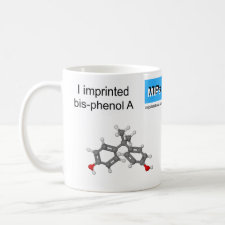
Authors: Yang BX, Xian QM, Liu HH, Liu-Jun, Yu HX
Article Title: The Synthesis of Bisphenol A Molecularly Imprinted Polymers and Investigation of Its Binding Characteristics.
Publication date: 2007
Journal: Journal of Nanjing University (Natural Sciences)
Volume: 43
Issue: (4)
Page numbers: 351-357.
Alternative URL: http://en.cnki.com.cn/Article_en/CJFDTotal-NJDZ200704006.htm
Abstract: Bisphenol A (BPA) has been receiving more and more attention in recent years because it has serious effects on the endocrine systems for ecosystem and human health. In this paper, the molecularly imprinted technology (MIT) was employed to synthesize a molecularly imprinted polymer (MIP) for BPA recognition. A series of molecularly imprinted nano-polymers for bisphenol A has been successfully fabricated by using different functional monomers, cross-linkers, initiators and porogens. The result showed that MIP with high selectivity for bisphenol A was obtained by selecting bisphenol A as the template molecule, 2-vinylpyridine as the functional monomer, azobisisobutyronitrile (AIBN) as the initiator, toluene as the porogen and trimethylolpropane trimethacrylate (TRIM) as the cross-linker. The synthesis conditions of the imprinting polymers were optimized and their selective binding characteristics were evaluated by Scatchard analysis. The multiple-site binding model was used to calculate the maximum number of binding sites and the favorable association constant. The results indicated that bisphenol A imprinted polymers had higher affinity character, compared with non-imprinted polymers. Scatchard analysis demonstrated that two different classes of the binding sites were formed in imprinted polymers which had different affinity to bisphenol A. The favorable association constant for bisphenol A binding to be KB=1.78×105 M-1. Density of the bisphenol A-specific receptor sites in the MIPs material was 7.23 μmol/g. The selective binding experiment for similar structure substrates revealed that the bisphenol A imprinted polymers gave much higher affinity and selectivity for bisphenol A than that for Phenol and Tetrabromobisphenol A. This study suggests that MIT may be a potential technique in the future for the selective separation, enrichment and determination of trace bisphenol A in complex environmental matrix.
Template and target information: bisphenol A, BPA
Author keywords: bisphenol A, molecularly imprinted polymer, Scatchard plot, affinity characteristic



Join the Society for Molecular Imprinting

New items RSS feed
Sign-up for e-mail updates:
Choose between receiving an occasional newsletter or more frequent e-mail alerts.
Click here to go to the sign-up page.
Is your name elemental or peptidic? Enter your name and find out by clicking either of the buttons below!
Other products you may like:
 MIPdatabase
MIPdatabase









